| |
|
|
|
|
|
|
|
|
|
|
| |
| |
 |
|
| |
田润德
编译文/图 2020-09-21
20:36 |
|
| |
|
|
|
|
| |
 |
|
|
|
| |
古斯塔夫.霍尔斯特(Gustav
Holst,1874——1934) |
|
|
|
| |
|
|
| |
北德廣播交響樂團 - 霍斯特:《行星》組曲之木星
|
|
|
|
| |
NDR
Radiophilharmonie - Gustav Holst: "The Planets" Op. 32 - Jupiter
【1080P/50fps】
|
|
|
|
| |
|
|
|
|
| |
音乐历史上的今天
1874年9月21日,古斯塔夫.霍尔斯特(Gustav
Holst,1874—1934)在切尔腾纳姆出生。“一个娇弱的孩子,近视,而且有哮喘。”
古斯塔夫·霍尔斯特(Gustav
Holst,1874—1934),英国作曲家。生于具有瑞典血统的音乐家庭。1893年入英国伦敦皇家音乐学院学习钢琴、管风琴、作曲和长号。后在歌剧乐队中任第一长号手、管风琴手。1905年起,曾提任过伦敦圣保罗女子学校音乐科主任,皇家音乐学院作曲教授。其代表作有为供大型管弦乐队演奏的组曲《行星》(作品32,由七个乐章组成),歌剧《赛维特丽》、《在野猪头酒家》,舞剧《大笨蛋》、管弦乐《圣保罗组曲》等,其中《行星》组曲最为著名。
古斯塔夫·霍尔斯特(Gustav
Holst)19岁时,进入伦敦皇家音乐学院,师事查尔斯·斯坦福五年。在音乐写作上,除大胆地进行和声的实验外,也采用多调的作曲手法。代表作为管弦乐组曲《行星组曲》(The
Planets)。《行星》组曲是一部庞然巨著,整个作品分为七个乐章,分别以九大行星中的七个星球(地球和当时尚不为人类所知的冥王星除外)命名,而且乐队编制也异常庞大,启用了一般很少登台的低音长笛、低音双簧管、低音单簧管、低音大管、次中音大号等管乐器,以及管风琴和众多的打击乐器,在最后一个乐章中还有一段六声部的女声合唱(有时亦以两支独奏长笛取代)。
如此众多的乐器的组合产生了丰富的音响色彩,如在"火星"乐章的一段音乐中,乐队的全奏展示出了地动山摇的气势。但也许正是由于《行星》组曲本身及其乐队编制过于庞大,这部作品一般很少全曲演奏,通常仅演其中的三、五个乐章,有时则只是单独演奏一个乐章。就《行星》组曲的意义来说,该曲与纯粹的天文学并无关系,而仅仅是建立在古代迦勒底人、中国人、埃及人和波斯人所熟悉的"占星术"之上的。关于这一点,霍尔斯特在1920年全曲公演时曾这样对记者说:"这些曲子的创作曾经受到诸行星的占星学意义的启发。它们并不是标题音乐,也与古代神话中的同名神仙
没有任何联系。如果需要什么音乐上的指引,那么,尤其是从广义上来说,每一曲的小标题足以说明与某些庆典活动有关的那种礼仪性的欢乐。例如,土星带来的不仅是肉体的衰退,它也标志着理想的实现,而水星则是心灵的象征……"
霍尔斯特繁忙的教学任务使他只能在周末和假期作曲:《行星组曲》由此也花了他三年时间才得以完成(1914-1916)。虽然心存疑惑的霍尔斯特并不认为这是他最杰出的作品,《行星组曲》却使他一夜成名。我们完全可以想象可怕的《火星》乐章对于那些深陷一战恐惧中的听众会产生何等大的震撼。这首曲子如此出名,大大盖过了作曲家的其他创作,几乎使之沦为“单曲作曲家”。它的家喻户晓,也使得人们常常忽视作品的新鲜创意。随着《海王星》乐章接近尾声,他借着幕后女声合唱的渐渐消逝唤起了人们的永恒意识,这种意识因人而异,但却同样具有丰富的想象力。《行星组曲》问世之时,英伦作曲界几乎没有任何与时代接轨的激进作品。当贾基列夫带着俄罗斯芭蕾舞团1913年到伦敦演出,英国作曲家们深受震动,尤其是霍尔斯特这批年轻音乐家,霍尔斯特的芭蕾舞剧《十足笨蛋》就是脱胎于这次冲击。《行星组曲》中新颖的音乐语汇和大型乐队编制同样可见《春之祭》的影响。
霍尔斯特祖籍瑞典,他的曾祖父于1807年移居到了英国。霍尔斯特出身于音乐世家,他的家族中曾出现过不少优秀的音乐家。霍尔斯特在英国的
切尔腾纳姆出生后,受家庭环境的影响,霍尔斯特很早便对音乐发生了兴趣,他的父亲也想把他培养成一个优秀的钢琴家。他在幼年时一直跟随父亲学习钢琴。1893年,十九岁的霍尔斯特考取了英国皇家音乐学院,学习钢琴和作曲,后因手指患神经炎而改学长号,从音乐学院毕业以后,他曾在几家剧院里担任长号手和合唱指挥;1905年,他担任了圣保罗女子学校的音乐教师;1907年又担任了伦敦莫利学院的音乐教师;1919年,霍尔斯特受聘担任了英国皇家音乐学院的作曲教授;1923年,他到了美国,在密执安、哈佛等大学讲学。晚年的霍尔斯特辞去了一切教学职务,专心于自己的音乐创作。1934年5月25日,霍尔斯特在英国伦敦逝世,终年六十岁。
今日视频:1、北德广播交响乐团演奏霍尔斯特:《行星》組曲之
《木星》;2、加利西亚交响乐团演奏霍尔斯特《行星组曲》,
op. 32;3、纪录片《行星》(中文字幕)。 |
|
|
|
| |
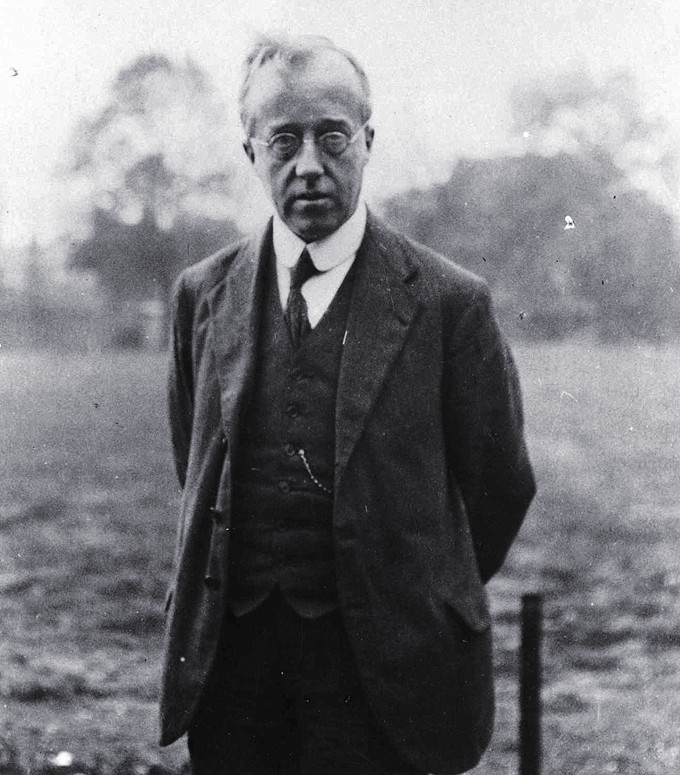 |
|
| |
古斯塔夫.霍尔斯特(Gustav Holst) |
|
|
|
| |
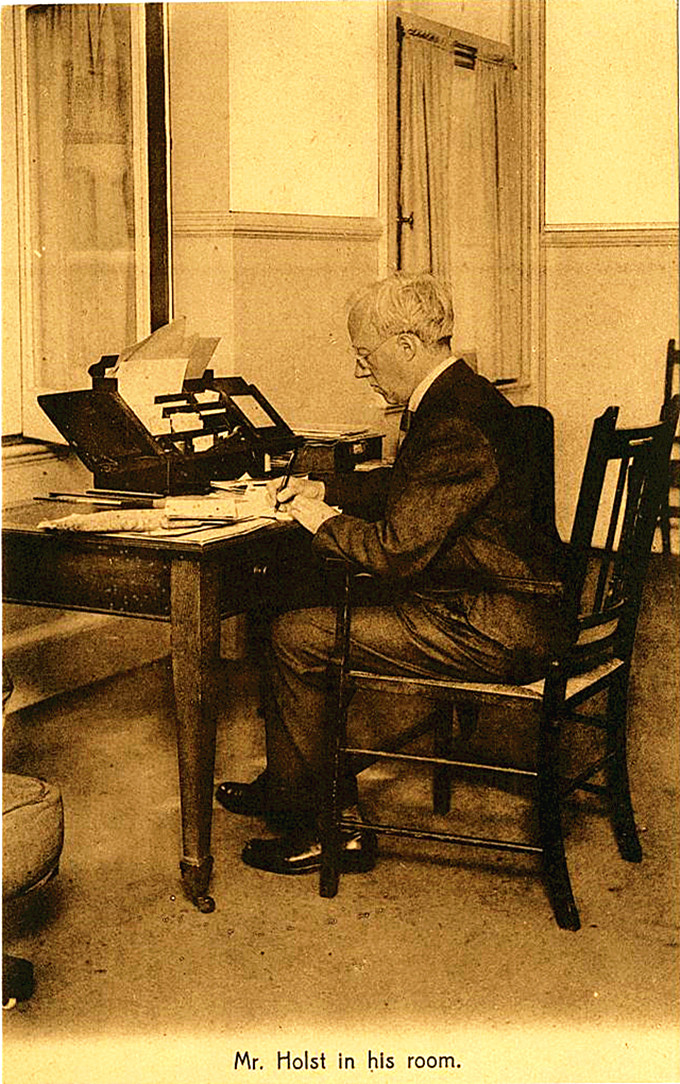 |
|
| |
古斯塔夫.霍尔斯特(Gustav Holst)在作曲 |
|
|
|
| |
 |
| |
1916年,他在教堂组织和指挥了第一次圣灵降临节,他把他在伦敦莫利学院的学生(包括杰克·普特瑞尔)召集到萨克斯特德合唱团参加巴赫的康塔塔和伯德的三声部弥撒。音乐是教堂服务的一部分,唯一的听众是会众。 |
|
|
| |
It was in 1916
that he organised and conducted the first Whitsun Festival in the
church, bringing his London pupils from Morley College (including Jack
Putterill) to join with the Thaxted choir in Bach cantatas and Byrd’s
Mass for Three Voices. The music was performed as part of the church
services, the only listeners were the congregation. |
|
|
|
| |
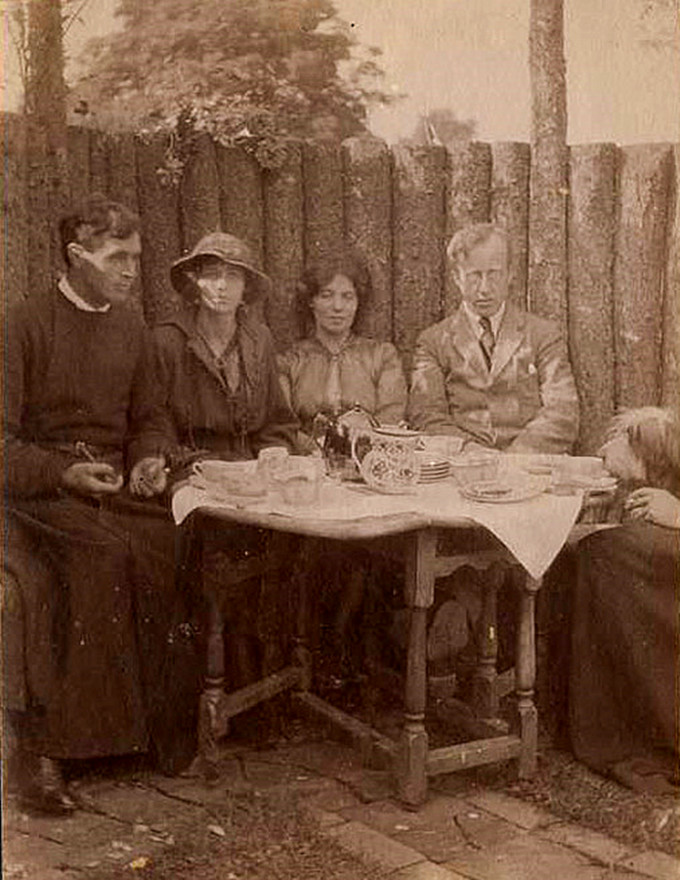 |
|
| |
年轻的古斯塔夫.霍尔斯特(Gustav
Holst)和家人在一起的光阴 |
|
|
|
| |
|
行星组曲《The Planets》介绍 |
行星组曲《The Planets》由英国作曲家Holst Gustav Theodor谱写。
《行星》组曲是一部庞然巨著,分为七个乐章,分别以八大行星中的七个星球(地球除外)命名,乐队编制也异常庞大,启用了一般很少登台的低音长笛、低音双簧管、低音单簧管、低音大管、次中音大号等管乐器,以及管风琴和众多的打击乐器,最后一个乐章中还有一段六声部的女声合唱(有时以两支独奏长笛取代)。如此众多乐器的组合产生了丰富的音响色彩,如在“火星”乐章的一段音乐中,乐队的全奏展示出了地动山摇的气势。但正是由于庞大,这部作品一般很少全曲演奏,通常仅演其中的三、五个乐章,有时则只是单独演奏一个乐章。
《行星》组曲与纯粹的天文学并无关系,而仅仅是建立在古代迦勒底人、中国人、埃及人和波斯人所熟悉的“占星术”之上的。霍尔斯特在1920年公演时曾对记者说:“这些曲子的创作曾受到诸行星的占星学意义的启发。它们并不是标题音乐,也不与古代神话中的同名神仙有任何联系。如果需要什么音乐上的指引,那么,尤其是从广义上来说,每一曲的小标题足以说明与某些庆典活动有关的那种礼仪性的欢乐。例如,土星带来的不仅是肉体的衰退,它也标志着理想的实现,而水星则是心灵的象征……”
第一乐章《火星——战争之神》:霍尔斯特是在1914年8月第一次世界大战爆发前夕完成这一乐章的。因此有人认为,这段音乐是对当时迫在眉睫的战争的预言。确实,这一乐章的音乐,尤其是由打击乐器和弦乐器弓杆击弦奏出的蛮横、激昂的渐强节奏型,暗示出军队在行进,给人以一种咄咄逼人的紧迫感。-
第二乐章《金星——和平之神》:与上一乐章凶残的战争音乐形成了鲜明的对比,这一乐章显得格外宁静安谧。它使人想起了一个没有电闪雷鸣、远离战争喧嚣的世外桃源,到处呈现出一派和平安乐的景象。评论家认为,长笛和法国号的延音表达蝉鸣,竖琴表现溪水,种琴和钢片琴表现清泉,小提琴表现情歌。
第三乐章《水星——飞行使者》:传说中水星是带有翅膀的信使的象征,也是窃贼的保护神。因而,这一乐章的音乐机敏灵活,是一首急板谐谑曲。第一主题轻捷而又俏皮,表现信使忙碌地走家串户,为人类带来福音;第二主题带民歌风格,表现人类欢迎信使的情景。
第四乐章《木星——欢乐使者》:这一乐章构思宏大,篇幅也较长,可分为三部分:第一部分气势浩荡,欢乐的情绪此起彼落,绵亘不绝。这一乐章经常被单独演奏,成为受人喜爱的通俗音乐作品。它又分为三个主题:第一主题为C大调,快板,2/4拍,喜悦的情绪十分明显;第二主题充满生机,热情洋溢,富有气势;第三主题转为3/4拍,象一首民间舞曲,气氛热烈。第二部分由原来的快板转为行板,为一首雄壮的“欢乐颂歌”,类似东方五音音阶的旋律,亲切感人,朴实生动,又不乏庄严与伟岸。第三部分为第一部分的反复。
第五乐章《土星——老年使者》:是组曲中最精彩的篇章之一,也是经常被单独演奏的段落。乐章以长笛、大管和两架竖琴奏出的由两个邻音交替构成的固定节奏开始,象征老年人蹒跚、滞重而单调的步态。它不仅表现“肉体的衰退”,更有着“理想的实现”的慰藉。这里,有葬礼的节奏,晚祷的钟声,对人生的思考,也有美好的回顾。
第六乐章《天王星——魔术师》:作者在这里运用了变幻无常的调性和配器色彩,以及力度的突兀变化等现代作曲手法,起到了扑朔迷离的效果。
第七乐章《海王星——神秘主义者》这最后一个乐章在给人以娴静温柔之感的同时,又表现出神秘莫测与朦胧的太空景象。乐章的第一主题就是以这种色调构筑起来的。钢片琴、竖琴和小提琴的大量运用,渲染出迷茫的神奇景象。这一乐章使用用了合唱来增加效果。总谱上注明:“合唱队应置于舞台边邻近的房间内,房门要开着,直到全曲的最后一小节,这时门要轻轻地、静静地关上。合唱队,门,以及可能需要的任何一些副指挥,都要用屏幕与听众隔开。”
一些评论者认为,《行星》组曲,反映了霍尔斯特在科学进步一发展的时代,表达在众行星间的宇宙漫游,而不再拘泥于关于行星的古代传说,不再是宗教崇拜,认为这部作品是科幻音乐的开端,并影响了后来的《星球大战》、《异形》等电影配乐。
著名日本游戏公司GAME FRANK的办公室是以行星组曲为主题的。
|
|
|
|
|
| |
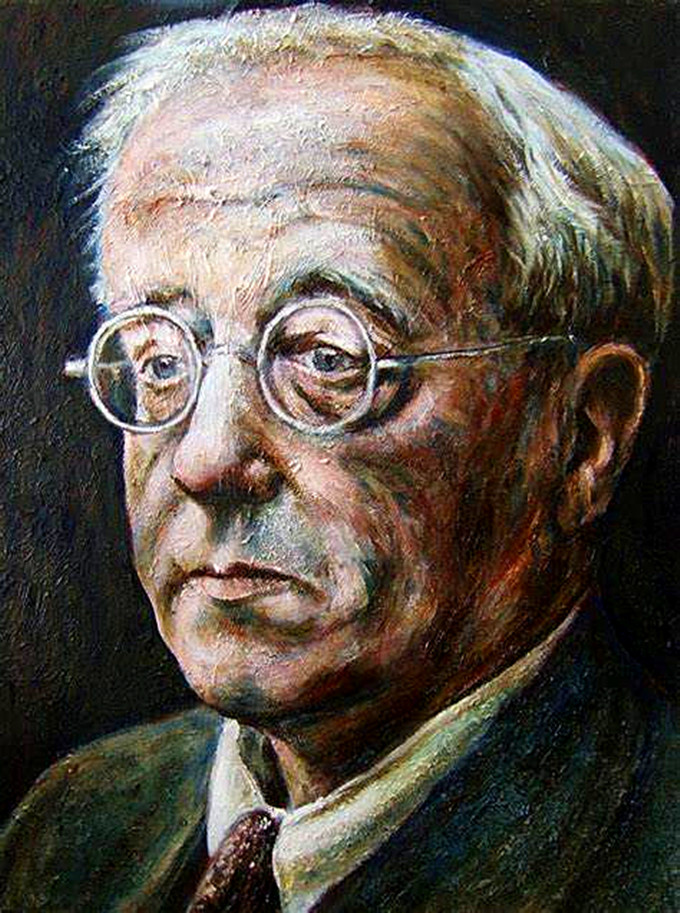 |
|
|
|
| |
古斯塔夫.霍尔斯特(Gustav Holst)漫相 |
|
|
|
| |
Country
music legend Kenny Rogers died March 20, 2020 from natural causes at age
81. The hall-of-fame singer will be missed by not only his fans, but by
his wife, Wanda Miller, and his five children.
Rogers was known for his close friendship with collaborator Dolly
Parton, and he had four previous marriages. But his commitment to Miller
lasted the longest after the two wed in 1997. When asked why his
previous marriages failed, the singer told Reuters that it was because
of his commitment to his music career. "When I became driven and selfish
I was so intent to follow my life that it cost me. I was gone so much
from some of my marriages that there was a disconnect," he said. "I
blame myself and my chosen field of music. That's why I say that music
is a mistress, because you can't wait to get out there to it, and
usually the mistress wins in a situation like that."
Rogers and Miller had clearly found a balance that stood the test of
time — they'd been married more than 22 years and had two children
together before Rogers passed away. Let's take a closer look at what
made Miller and her union with "The Gambler" so special. |
|
|
|
| |
 |
|
| |
|
古斯塔夫.霍尔斯特(Gustav Holst)和伊泽贝尔霍尔斯特,获得霍尔斯特信托、切尔滕纳姆信托和切尔滕纳姆区委员会的许可 |
|
Gustav and Isobel Holst, reproduced with permisssion from The
Holst Trust,The Cheltenham Trust and Cheltenham Borough Council |
|
|
|
|
| |
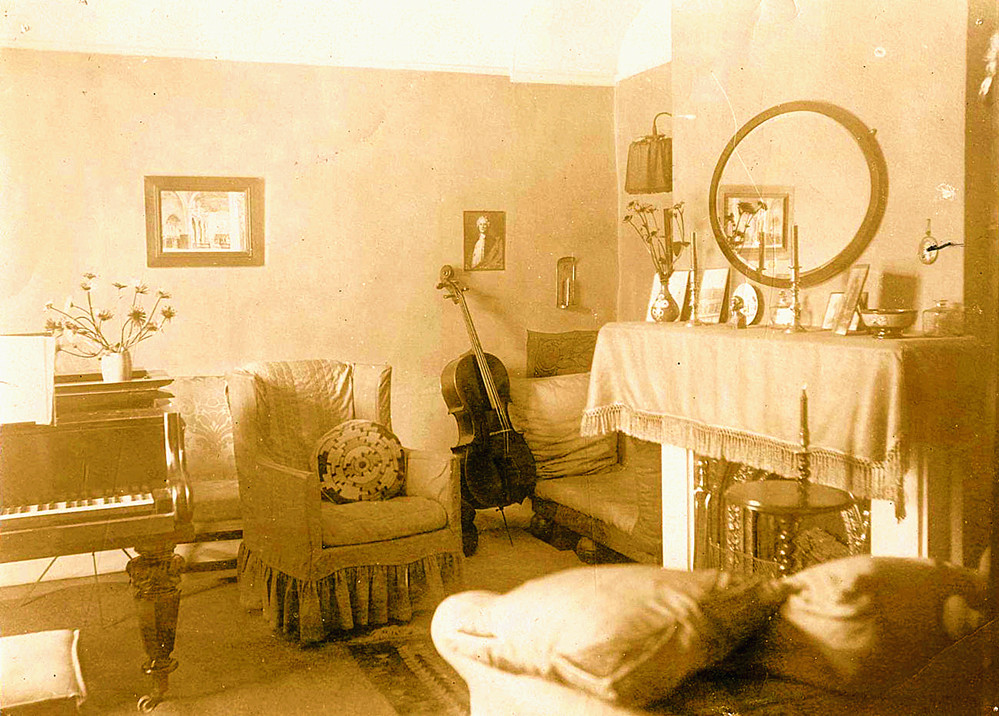 |
|
| |
古斯塔夫.霍尔斯特(Gustav
Holst)曾经住过的地方,行星就是在这里创作的。 |
|
|
|
| |
“ The
Manse”前门附近的牌匾位于他1917至1925年间音乐室的墙壁上。这是一个安静的作曲场所。他在那里度过了整个1924年,从疾病中恢复过来,并在他的合唱交响乐团工作。他写给朋友说:“这真是太好了”,“整天坐在花园里,看着交响乐在鲜花和蔬菜旁边长大,然后发现它完成了!”
我们于1925年离开Thaxted,但他从未与朋友失去联系。在他生命的最后一个冬天,他希望去教堂过圣诞节。但是他还不够好,他在五个月后的1934年圣灵降生周去世,享年59岁。他的传统得以延续。伯德弥撒音乐节的凯里(Kyrie)仍然在每个星期日演唱,他的“萨克斯泰颂歌”则在每个圣诞节早晨播放。
1917年的音乐横幅仍在游行队伍中随教会携带:褪色的丝绸已经完美地更新过,巴赫的话语仍然宣告“音乐的目标是上帝的荣耀和愉快的娱乐。”
|
|
|
|
| |
The plaque
near the front door of ‘The Manse’ is on the wall of what was his
music-room from 1917 to 1925. It was a peaceful place for composing. He
spent the whole of 1924 there, recovering from an illness, and working
at his Choral Symphony. ‘It has been wonderful’, he wrote to a friend,
‘to sit all day in the garden and to watch the symphony grow up
alongside of the flowers and vegetables, and then to find that it is
done!’
We left Thaxted in 1925, but he never lost touch with his friends. In
the last winter of his life he was hoping to get to the church for
Christmas. But he was not well enough, and he died five months later, in
the Whitsun week of 1934, at the age of fifty-nine. His tradition lives
on. The Kyrie from the Byrd Mass is still sung every Sunday, and his
‘carols for Thaxted’ are played every Christmas morning. The 1917
music-banner is still carried round the church during processions: its
faded silk has been beautifully renewed, and Bach’s words, which he
chose, still announce that ‘the aim of music is the glory of God and
pleasant recreation.’efinition of "love at first sight," right? |
|
|
|
| |
 |
|
| |
抬头仰望,满天星斗,浩瀚的星空会引起人们无限的遐想,激发人们去探索宇宙天体的奥秘。 |
|
|
|
| |
 |
|
| |
行星的形成 |
|
|
|
| |
“在太阳系形成初期,99%以上的物质向中心聚合成为太阳,周围还有部分散在的物质碎片围绕着太阳旋转,经过很长一段时间的碰撞和引力作用,散在的碎片逐渐聚合成了九大行星,但那时的地球只是一团混沌的物质,又经过了几十万年,物质逐渐冷却凝固,形成了地球的初步形态,再经过几十万年,由于地球的引力作用,由地球内部化学反应所产生的气体喷出后被保存在地球周围,形成了大气层,并由氢气和氧气化合成了水,再然后经过太阳的能量辐射,地球本身的电场、磁场作用和适宜的生存环境,由水中产生了有机物,也就是一切生命的祖先……二、最新说法
有研究认为:行星是从黑洞中产生的。并为此找到了确凿的证据:银河系中央的小型黑洞能够超速“喷射”行星。在此之前,科学家认为只有特大质量黑洞才能以超速喷射行星。研究人员称,实际上小型黑洞要比特大质量黑洞喷射更多数量的行星。1988年,美国洛斯·阿拉莫斯...” |
|
|
|
| |
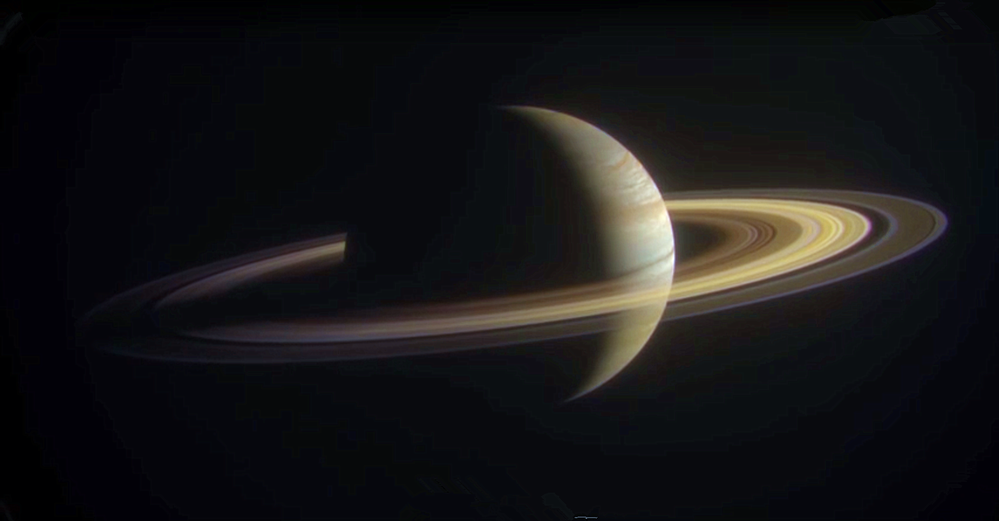 |
|
| |
这就是土星的造型 |
|
|
|
| |
|
让霍尔斯特为我们科普一下“八大行星” |
|
八大行星,是指太阳系的八个大行星,按照离太阳的距离从近到远,它们依次为水星(☿)、金星(♀)、地球(⊕)、火星(♂)、木星(♃)、土星(♄)、天王星(♅)、海王星(♆或⛢
[1]
)。八大行星自转方向多数也和公转方向一致。只有金星和天王星两个例外。金星自转方向与公转方向相反,天王星则是与公转轨道呈97°角的“躺着”旋转。
每个行星的公转速度都是不同的,大部分时间里,它们会分散在太阳的周围,但每隔175年,就会出现一个相当奇妙的现象,太阳系外层的这几颗行星会排成一条线,这就打开了一条从地球出发途径木星和土星的通道,并且能一直通向天王星和海王星
几乎所有的行星,都是沿自转轴以逆时针的方向旋转。但出于一些我们尚未完全理解的原因,金星和天王星都是以反方向自转的。
天王星更是让人好奇,整个星球都倒向一侧。
行星的定义:一是必须围绕恒星运转的天体;二是质量足够大,能依靠自身引力使天体呈圆球状;三是这个轨道附近应该没有其他物体(清理其轨道上的其它物体)。按这样的划分,太阳系的行星就只有水、金、地、火、木、土,加上天王、海王这八颗。
与2006年之前提到的九大行星概念不同,在2006年8月24日于布拉格举行的第26届国际天文学联会中通过的第5号决议中,冥王星被划为矮行星,从太阳系九大行星中被除名。大行星必须是围绕恒星运转的天体,质量足够大、能依靠自身引力使天体呈圆球状,这些冥王星都相符。但是冥王星没有能够清空其轨道上的其它物体,因此冥王星被归为矮行星。从此太阳系从九大行星变成了八大行星。 |
|
|
|
|
| |
|
|
|
|
| |
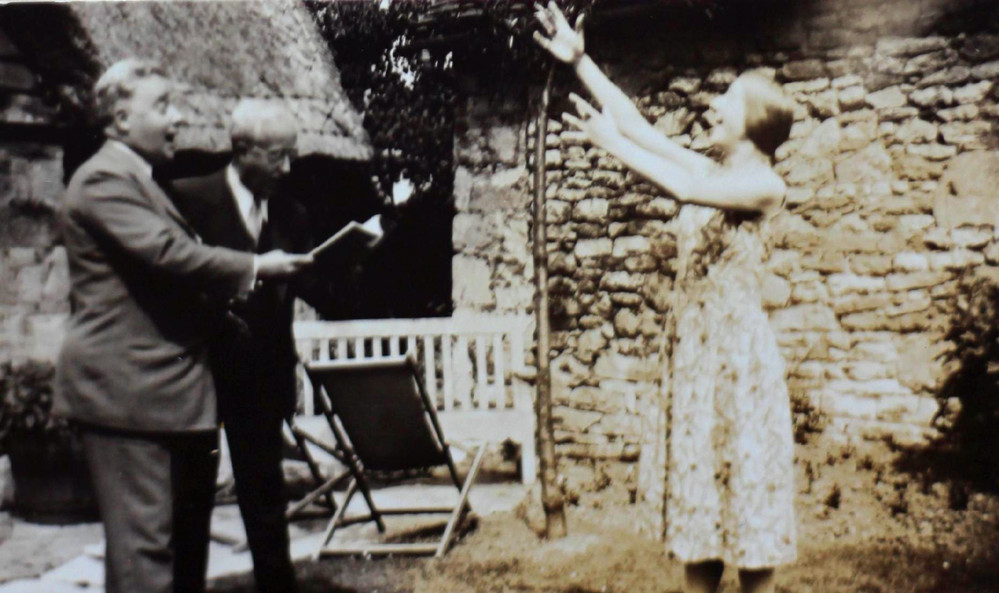 |
|
| |
霍尔斯特基金会 |
|
|
|
| |
霍尔斯特基金会由古斯塔夫·霍尔斯特的女儿伊莫金·霍尔斯特(1907-84)于1981年创立,霍尔斯特基金会是一个捐赠慈善机构,在过去30多年里,其资金主要用于在世作曲家的音乐表演和录音。在此期间,提供的赠款总额达300多万笔。在1984年版权最初到期后,伊莫金·霍尔斯特不打算通过该基金会支持霍尔斯特音乐的演出或出版。这是通过管理霍尔斯特房产的公司进行的。在1997年的版权立法将版权期限延长至70年之后,主要版权终于在2004年底到期,公司被并入基金会。霍尔斯特基金会从一开始就是靠版税来资助的,大多数资助活动都在2014年结束。对1988年在该基金会赞助下创立的NMC唱片公司的年度资助已于2016年终止。尽管基金会希望能够在有限的基础上由其音乐委员会决定资助选定的项目,但申请资助的申请将不再被接受。该基金会继续管理古斯塔夫和伊莫金·霍尔斯特的财产,他们的档案现在由奥尔德堡的布里顿-皮尔斯基金会持有,该基金会还管理着伊莫金·霍尔斯特的故居——教堂步道9号,可供作曲家居住:可以向grants@brittenpears.org申请。欲了解更多详情,请访问布里顿·皮尔斯基金会网站 |
|
|
|
| |
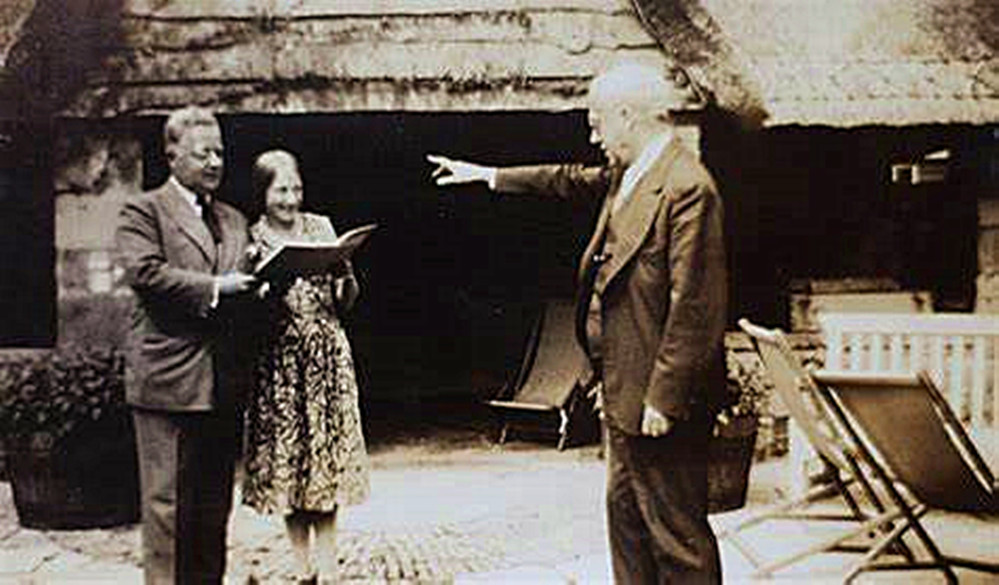 |
|
| |
About the Holst
Foundation
Founded in 1981 by Imogen Holst (1907-84), the daughter of Gustav Holst,
the Holst Foundation is a grant-giving charity whose funds were for more
than 30 years directed primarily towards the performance and recording
of music by living composers. The total of grants awarded during that
period amounted to over £3 million. Imogen Holst did not intend to
support performance or publication of Holst’s music through the
Foundation after the initial expiry of copyright in 1984. This was done
in a small way through the company which administered the Holst Estate;
subsequent to the copyright legislation of 1997 which extended copyright
to 70 years, the major copyrights finally expired at the end of 2004,
and the company was incorporated into the Foundation.
The Holst Foundation was from its inception funded from royalties, and
most grant-giving activities came to an end in 2014. The annual grant to
NMC Recordings, which was created under the auspices of the Foundation
in 1988, was discontinued in 2016. Applications for grants are no longer
accepted, although the Foundation hopes to be able to fund selected
projects on a limited basis at the discretion of its Music Committee.
The Foundation continues to administer the estates of both Gustav and
Imogen Holst, whose Archives are now held by the Britten-Pears
Foundation in Aldeburgh, who also administer Imogen Holst’s former home,
9 Church Walk, which is available for composer residencies: applications
may be made to grants@brittenpears.org. For further details visit the
Britten Pears Foundation website. |
|
|
|
| |
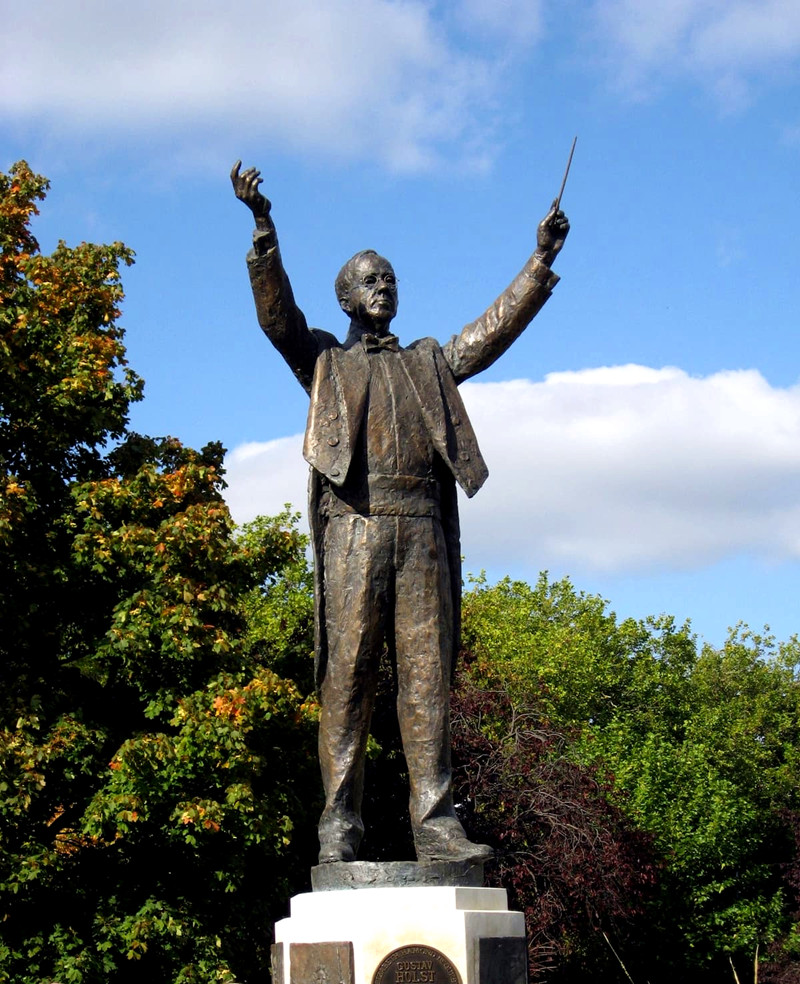 |
|
|
|
| |
切尔滕纳姆的古斯塔夫·霍尔斯特雕像 |
|
|
|
| |
Statue of Gustav Holst in
Cheltenham |
|
|
|
| |
|
|
|
|
| |
Today in the
history of music
On September 21, 1874, Gustav.Gustav Holst (1874 -- 1934) was born in
Cheltenham."A delicate child, short-sighted and asthmatic."
Gustav Holst (1874 -- 1934) was an English composer.Born into a musical
family of Swedish descent.In 1893, he entered the Royal College of Music
in London, England, to study piano, organ, composition and
trombone.Later in the opera band as the first trombonist, organist.Since
1905, he has been director of music Section of St Paul's School for
Girls in London and professor of composition at the Royal College of
Music.His masterpieces include the suite The Planet (Op. 32, consisting
of seven movements) for large orchestras, the opera Seville, The Wild
Pig's Head, the dance drama Bonehead and the orchestral Suite Sao Paulo,
among which the Planet suite is the most famous.
Gustav Holst (September 21, 1874 -- May 25, 1934) was a British
composer.Most of the ancestors were British, the rest Were Swedes.At the
age of 19, he enrolled at the Royal College of Music in London, where he
studied with Charles Stanford for five years.In music writing, in
addition to the bold harmony experiment, also adopts the multi-tone
composition technique."Is for" The Planets "as an orchestral
suite."Planet" suite is a mighty tome, the whole work is divided into
seven movement, with seven of the nine planets planet (the earth and
then it is not known to the human except Pluto), and the band is
unusually large, general rarely enabled on the stage of bass flute,
oboe, bass clarinet, fill, tenor large wind instruments, and the organ
and many percussion instruments, in a period of six parts in the last
movement of female chorus is replaced with two solo flute (sometimes).
The combination of so many instruments produces rich sound colors. For
example, in a piece of "Mars" movement, the ensemble of the orchestra
shows the momentum of the earth shaking.But perhaps because of the sheer
size of the Suite itself and its orchestra, the piece is rarely played
in its entirety, usually in three or five movements, sometimes in a
single movement.In the sense of the Planets suite, it has nothing to do
with pure astronomy but is based on astrology as it was known to the
ancient Ledeans, The Chinese, the Egyptians and the Persians.On this
point, Holst told reporters at the 1920 premiere of the full piece:
"These compositions were inspired by the astrological significance of
the planets.They are not title music, nor do they have anything to do
with the gods of the same name in ancient mythology.If musical guidance
is needed, then, especially in a broad sense, the subtitle of each song
is sufficient to indicate the kind of ceremonial joy associated with
certain celebrations.Saturn, for example, brings not only physical
decay, but also the fulfillment of ideals, while Mercury is the symbol
of the heart..."
Holst's busy teaching schedule meant that he had to compose on weekends
and holidays: "The Planetary Suite" took him three years to complete
(1914-1916).Although a skeptical Holst did not consider it his finest
work, "The Planetary Suite" made him an overnight sensation.We can well
imagine how the terrifying music of Mars would have shaken listeners in
the depths of their first world War fears.The piece became so famous
that it overshadowed everything else the composer had written, almost
relegating it to the status of a "songwriter".It is a household name,
but also makes people often ignore the work of fresh ideas.As The
movement of Neptune draws to a close, he evokes a sense of permanence
that varies from person to person, but is equally imaginative, with the
fading of the female chorus behind.At the time of the publication of The
Planetary Suite, there were hardly any radical works in British literary
music that were in line with The Times.When Jakilev took the Russian
Ballet to London in 1913, British composers, especially young musicians
like Holst, were shocked. Holst's ballet "Full Fool" was born out of
this shock.The influence of The Rite of Spring can also be seen in the
novel musical vocabularies of The Planetary Suite and the large band
arrangements.Originally from Sweden, Holst's great-grandfather emigrated
to Britain in 1807.Holst comes from a musical family that has produced
some great musicians.Holst was born on September 21, 1874, in
Cheltenham.Influenced by his family, Holst became interested in music at
an early age, and his father wanted to develop him into an excellent
pianist.He had been learning the piano from his father when he was a
child.In 1893, at the age of 19, Holst was admitted to the Royal College
of Music, where he learned to play the piano and compose music. Later,
he developed neuritis in his fingers and changed to senior trumpet.
After graduating from the College of Music, he worked as a trombonist
and chorus conductor in several theaters.In 1905, he became music
teacher at St. Paul's Girls' school;In 1907 he was appointed music
teacher at Morley College, London;In 1919, Holst was appointed professor
of composition at the Royal College of Music;In 1923, he went to the
United States and lectured at Michigan, Harvard and other
universities.Later in life Holst resigned all teaching duties to
concentrate on his music.On May 25, 1934, Holst died in London, England,
at the age of sixty.
Today's videos: 1. North German Radio Symphony Orchestra - Horst:
Jupiter of the Planet suite; 2. Galicia Symphony by Holst, Op. 32;3.
Documentary Planet (Chinese subtitles). |
|
|
|
| |
|
|
|
|
| |
|
|
| |
加利西亚交响乐团演奏霍尔斯特《行星组曲》, op. 32 |
|
|
|
| |
古斯塔夫·霍尔斯特(1874 - 1934)
行星组曲, op. 32
乐团:加利西亚交响乐团
指挥:迪玛·斯洛博登努克
GUSTAV HOLST (1874-1934)
Los planetas, op. 32
乐团:Orquesta Sinfónica de Galicia
指挥:Dima Slobodeniouk |
|
|
|
| |
|
|
|
|
| |
|
|
| |
纪录片《行星》(中文字幕) |
|
|
|
| |
行星 - THE PLANETS Space Documentary [中文字幕] |
|
|
|
| |
|
|
|
|
| |
未得原作者编者授权严禁转载www.mt77.com任何内容 |
|
|
|
|
|
|
|
|
|
|
|
|
|
|


